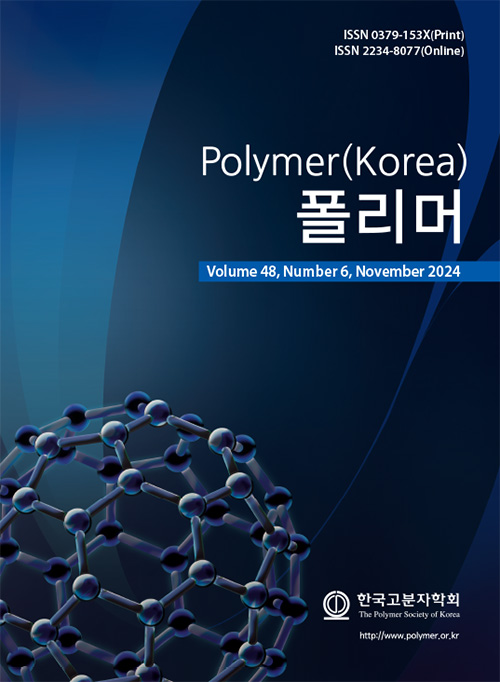- Highly Sensitive All-PEDOT:PSS Organic Electrochemical Transistors by Tuning the Channel-geometry Using Laser-induced Patterning
Seong Yeon Park# , Seo Yeong Son# , Hyuckjin Nam, Boeun Ryu, and Changhun Yun†

School of Polymer Science and Engineering, Chonnam National University, Gwangju, 61186, Korea
- 레이저 패터닝을 이용한 채널 구조 조절에 따른 PEDOT:PSS 기반 전기화학 트랜지스터의 성능 향상 연구
전남대학교 고분자융합소재공학부
Reproduction, stored in a retrieval system, or transmitted in any form of any part of this publication is permitted only by written permission from the Polymer Society of Korea.
Poly(3,4-ethylenedioxythiophene):poly(4-styrenesulfonate) (PEDOT:PSS) has been utilized for both channel and gate materials of an organic electrochemical transistor (OECT) as a vitamin-C sensor, because it can sensitively convert biochemical signals into electronic signals. In this work, using highly conductive PEDOT:PSS film over 800 S/cm, we investigated the effect of channel geometry on the sensing performance of all-PEDOT:PSS OECT sensors fabricated by laser-induced patterning process. The channel geometry significantly affected the changing-rate of channel resistance values as well as the noise level of OECTs in an electrolyte solution. For a fixed size of gate and channel electrodes, the OECT with the smallest channel width and highest channel resistance performed 32.69% decrease in limit of detection (LOD) value and two times faster response time, compared to the OECT without tuning the channel.
대표적 전도성 고분자인 poly(3,4-ethylenedioxythiophene):poly(4-styrenesulfonate) (PEDOT:PSS)는 생물화학적 신호를 민감하게 전자 신호로 변환할 수 있으며 유기 전기화학 트랜지스터(OECT)의 채널 및 게이트 물질로 모두 사용될 수 있어 비타민 C 센서로 널리 활용되는 재료이다. 본 연구는 800 S/cm 이상 고전도성 PEDOT:PSS 필름과 레이저 미세 패터닝 공정을 이용하여 제작된 all-PEDOT:PSS OECT의 비타민 C 감지 성능 향상을 위하여, 채널의 구조가 OECT의 센싱 성능에 미치는 영향을 연구하였다. 특히 채널의 구조 변화가 phosphate-buffered saline(PBS) 전해질 내에 고전도성 PEDOT:PSS 필름을 담갔을 때 발생하는 채널 저항 변화율에 유의미한 차이를 유발함에 따라, 센서의 감도 및 검출한계에 미치는 영향을 규명하였다. 채널 및 게이트 면적이 일정할 때 최소 채널 폭과 최고 채널 저항을 가지는 형상의 OECT는 채널에 레이저 처리를 하지 않은 OECT와 비교하여 32.69% 감소한 limit of detection(LOD) 값을 얻었으며 약 2배 이상 빠른 응답 속도를 보였다.
Keywords: organic electrochemical transistor, vitamin C sensor, poly(3,4-ethylenedioxythiophene):poly(4-styrenesulfonate), laser patterning, ascorbic acid, limit of detection.
- Polymer(Korea) 폴리머
- Frequency : Bimonthly(odd)
ISSN 0379-153X(Print)
ISSN 2234-8077(Online)
Abbr. Polym. Korea - 2024 Impact Factor : 0.6
- Indexed in SCIE
 This Article
This Article
-
2024; 48(6): 693-700
Published online Nov 25, 2024
- 10.7317/pk.2024.48.6.693
- Received on Jul 9, 2024
- Revised on Jul 23, 2024
- Accepted on Aug 16, 2024
 Correspondence to
Correspondence to
- Changhun Yun
-
School of Polymer Science and Engineering, Chonnam National University, Gwangju, 61186, Korea
- E-mail: chyun2020@jnu.ac.kr








 Copyright(c) The Polymer Society of Korea. All right reserved.
Copyright(c) The Polymer Society of Korea. All right reserved.